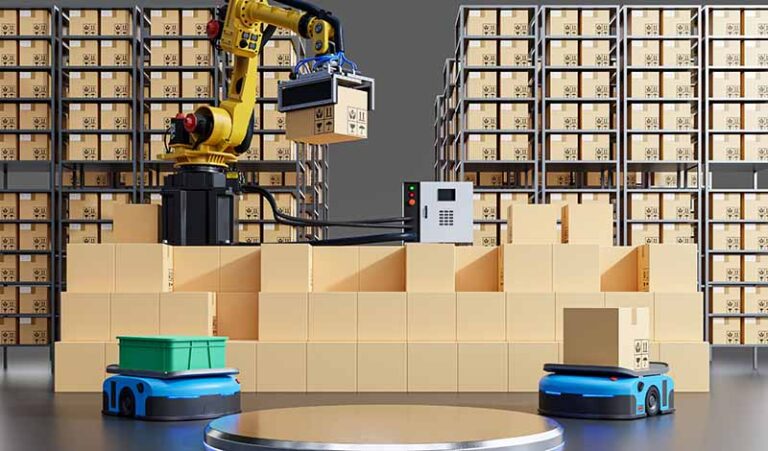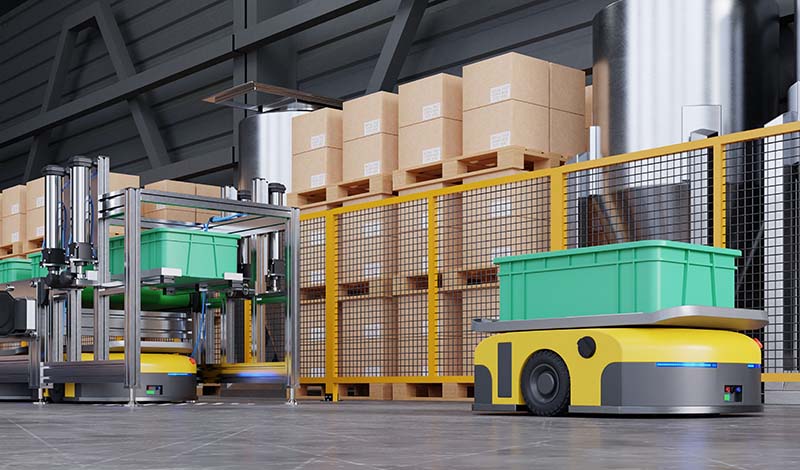Imagine a warehouse where machines handle most of the work. In a fully automated warehouse, advanced technologies like machine learning and artificial intelligence perform tasks that people used to do. These tasks include managing inventory, picking and packing orders, and moving items around the warehouse space.
Integration is key. A fully automated warehouse system isn’t just a few machines here and there. It’s a complete automation solution where different automated technologies work together seamlessly. This creates an efficient and unified system that improves warehouse operations.
So, what does a fully automated warehouse system really look like? At its core, it’s a set of different tools and procedures working together in harmony. Each part uses automation to perform tasks smartly.
Every business is unique, so each automated warehouse will be different. Here at Process Equipment & Controls (PEC), we help companies across various industries create automated warehouse systems that fit their specific needs. Let’s look at some common types of warehouse automation solutions and how they work.
1
In a goods-to-person system, items are brought directly to workers who pack and ship them. This reduces the need for workers to move around the warehouse picking orders. Instead, the items come to them, speeding up the process and reducing mistakes.
GTP systems often use autonomous mobile robots (AMRs) and automated storage and retrieval systems (AS/RSs):
2
Automated Guided Vehicles (AGVs) are similar to AMRs but usually follow fixed paths in the warehouse. They use sensors to know their location and software to understand their surroundings. AGVs transport items from one place to another, helping manage inventory and move products smoothly.
AGVs are great for warehouses with enough space to allow these vehicles to move safely. They help in optimizing warehouse operations by reducing manual handling.
3
Sortation systems use smart technology to sort items as they move along conveyor systems. As products travel down the conveyor belt, the system directs them to the correct packing stations. This speeds up the order fulfilling process and reduces errors.
4
A warehouse management system (WMS) is software that acts as the brain of the warehouse. It collects data from all over the warehouse, helping managers oversee operations even from remote locations.
The WMS integrates all the automated components into one unified system. Without a good WMS, it’s hard to get the full benefits of warehouse automation.
5
Some businesses still rely on their human workers but use technology to help them. Devices like handheld scanners and pick-to-light systems connect directly with the WMS. They provide real-time data and reduce human error.
Using a fully automated warehouse system can bring many benefits to your business. Let’s explore some of them:
1
Automation streamlines your warehouse operations. Tasks are done faster and more accurately. This means you can get orders out on time, every time. It also helps in optimizing warehouse processes, making your business more productive.
With machines handling repetitive tasks, you reduce delays and increase throughput. This efficiency boosts customer satisfaction and can lead to more business.
2
Your human workers are best at tasks that need creativity and problem-solving. They might not be as effective at repetitive and time-consuming tasks like picking and packing. Fully automated warehouse systems free up your human teams to focus on more valuable work.
By reallocating your staff to areas where they can make the biggest impact, you improve overall productivity and job satisfaction.
3
Automation reduces the need for people to be on the warehouse floor, which can be risky. Machines can handle heavy lifting and repetitive tasks, reducing the chance of injuries. This helps you maintain a safe work environment and comply with safety regulations.
With machines moving heavy packages, there’s less risk of accidents caused by falling or misplaced boxes. This creates a safer workplace for everyone.
4
When your warehouse runs smoothly, it benefits everyone in your supply chain. You can fulfill orders accurately and on time, making your partners and customers happy. This helps build strong, long-term relationships.
Many of our clients tell us they want to strengthen ties with distributors, manufacturers, and suppliers. Warehouse automation helps make this happen by improving efficiency and reliability.
5
Automated systems can help you use your warehouse space more efficiently. For example, automated storage and retrieval systems (AS/RSs) can store items in high or tight spaces that are hard for humans to reach. This means you can store more inventory without needing a bigger warehouse.
By reducing the need for aisles and traditional storage racks, you can maximize your available space and reduce costs.
6
Automation minimizes human errors in tasks like data entry, picking, and packing. Machines follow programmed instructions precisely, which leads to higher accuracy. This reduces mistakes that can cost time and money.
7
With automated systems, orders are processed and shipped more quickly. This speeds up the order fulfilling process, leading to happier customers who receive their products faster.
8
While setting up a fully automated warehouse requires an investment, the savings over time can be significant. Reduced labor costs, fewer errors, and improved efficiency all contribute to cost savings in the long term.

A fully automated warehouse uses machines and software to handle most of the work. Here’s how the different parts come together:
1
All the automated equipment and systems are connected through the warehouse management system (WMS). The WMS acts like the central control center, coordinating all activities.
For example:
2
Automation provides real-time data about inventory levels, equipment status, and order progress. Managers can make quick decisions to keep everything running smoothly.
3
While humans still play a role, especially in overseeing operations and handling exceptions, the need for manual labor is greatly reduced. This speeds up processes and reduces mistakes.
1
In today’s fast-paced market, customers expect quick delivery and accurate orders. Automation helps you meet these expectations and stay ahead of competitors.
2
As your business grows, automation allows you to handle more orders without needing to hire many more workers. This scalability is crucial for expanding businesses.
3
Automation streamlines processes, reduces downtime, and increases throughput. This helps you improve efficiency and productivity.
4
With faster and more accurate order fulfillment, customer satisfaction increases. Happy customers are more likely to return and recommend your business to others.
Before implementing a fully automated warehouse system, consider the following:
1
Automation requires upfront costs for equipment and software. However, the return on investment can be significant over time through cost savings and increased efficiency.
2
Your team will need training to work with the new systems. It’s important to manage this change carefully to ensure a smooth transition.
3
Automated systems need regular maintenance to keep them running efficiently. Having a plan for upkeep is essential to avoid disruptions.
Technology is always advancing, and warehouses are becoming even smarter. Here are some trends to watch:
1
These technologies enable systems to learn and improve over time, optimizing processes even further.
2
Connecting devices and sensors throughout the warehouse provides more data and control, enhancing decision-making.
3
Some warehouses are experimenting with drones for inventory checks and advanced robots for complex tasks.

If you’re considering automating your warehouse, here are steps to follow:
A fully automated warehouse offers many benefits, from increased efficiency to better customer satisfaction. By integrating advanced technologies like AMRs, AGVs, and a strong warehouse management system (WMS), you can transform your warehouse operations.
At PEC, we’re committed to helping businesses like yours harness the power of automation. Whether you’re looking to optimize your current warehouse or build a new one from scratch, we’re here to support you.
Contact us today to learn more about how we can help you create a fully automated warehouse system tailored to your needs.
By implementing a fully automated warehouse, you position your business for success in the modern marketplace. With the right automation solutions, you can streamline operations, reduce costs, and delight your customers.